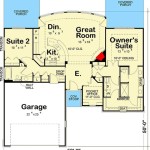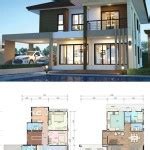Drawing house plans for free involves creating detailed blueprints and schematics of a residential building without incurring any monetary expenses. These plans serve as visual representations of a house’s layout, dimensions, and architectural features. Individuals can utilize free software and online platforms to design and customize their own house plans, empowering them with the ability to visualize their dream homes without the need for professional assistance.
Whether you’re a first-time homeowner or an experienced builder, drawing your house plans for free offers several advantages. It allows you to tailor your design to your specific needs and preferences, saving you both time and money on architectural fees. Additionally, free house plan software often provides a wide range of templates and tools, making the design process accessible to users of all skill levels.
In the following sections, we’ll explore the intricacies of drawing house plans for free, providing step-by-step guidance and valuable tips to ensure successful outcomes. We’ll delve into the capabilities of free software, discuss the advantages and limitations of DIY house plan design, and highlight real-world examples of homeowners who have successfully built their dream homes using free resources.
When drawing house plans for free, there are several key points to keep in mind:
- Use free software and online tools
- Start with a basic floor plan
- Consider your needs and preferences
- Pay attention to scale and dimensions
- Include all necessary details
- Review and revise your plans
- Get feedback from others
- Consider local building codes
- Be prepared to make changes
- Don’t be afraid to ask for help
By following these guidelines, you can create house plans that meet your specific needs and requirements without incurring any design costs.
Use free software and online tools
When drawing house plans for free, one of the most important steps is to choose the right software. There are a number of free software programs and online tools available that can help you create professional-looking house plans, even if you don’t have any prior experience with CAD software.
- SketchUp is a free 3D modeling program that is perfect for creating house plans. It is easy to use and has a wide range of features, making it a great choice for both beginners and experienced users.
- Floorplanner is an online tool that allows you to create 2D and 3D floor plans. It has a user-friendly interface and a large library of objects and symbols, making it a great choice for quickly creating basic house plans.
- Sweet Home 3D is another free 3D modeling program that is specifically designed for creating house plans. It has a wide range of features, including the ability to import 2D floor plans and create 3D models.
- LibreCAD is a free 2D CAD program that can be used to create house plans. It is not as user-friendly as some of the other options, but it is a powerful tool that can be used to create detailed and accurate house plans.
Once you have chosen a software program or online tool, you can begin creating your house plans. Start by creating a basic floor plan, then add walls, doors, windows, and other features. Be sure to pay attention to scale and dimensions, and include all necessary details.
Start with a basic floor plan
The first step in drawing house plans is to create a basic floor plan. This will give you a general idea of the layout of your house and the placement of the rooms. To create a basic floor plan, start by drawing a rectangle to represent the perimeter of your house. Then, divide the rectangle into smaller rectangles to represent the different rooms. Be sure to include all of the rooms that you want in your house, such as bedrooms, bathrooms, kitchen, living room, and dining room.
Once you have created a basic floor plan, you can start to add details. Draw in the doors and windows, and indicate the location of the stairs. You can also start to think about the placement of the furniture and appliances. As you add details to your floor plan, be sure to keep in mind the scale of your house. The scale will help you to ensure that the rooms are the right size and that the furniture is properly proportioned.
Once you are satisfied with your basic floor plan, you can start to draw the exterior walls of your house. The exterior walls should be drawn to scale, and they should include all of the windows and doors. Once you have drawn the exterior walls, you can start to add the roof. The roof should be drawn to scale, and it should include all of the chimneys and dormers.
Once you have completed your basic floor plan and exterior elevations, you can start to add the finishing touches. These finishing touches may include things like the landscaping, the driveway, and the walkway. Once you have added the finishing touches, your house plans will be complete.
Consider your needs and preferences
When drawing house plans for free, it is important to consider your needs and preferences. This includes thinking about the size of your house, the number of bedrooms and bathrooms you need, the style of house you want, and the features that are important to you. Here are some things to consider when thinking about your needs and preferences:
- The size of your house: How many people will be living in the house? How much space do you need? Do you need a lot of storage space?
- The number of bedrooms and bathrooms you need: How many bedrooms and bathrooms do you need now? How many do you think you will need in the future?
- The style of house you want: What style of house do you like? Do you want a traditional house, a modern house, or something in between?
- The features that are important to you: What features are important to you in a house? Do you want a large kitchen? A big backyard? A fireplace?
Once you have considered your needs and preferences, you can start to draw your house plans. Be sure to keep your needs and preferences in mind as you make decisions about the layout of your house, the size of the rooms, and the features that you include.
Here are some additional things to consider when thinking about your needs and preferences:
- Your budget: How much money can you afford to spend on building your house?
- The location of your house: Where do you want to live? What kind of neighborhood do you want to live in?
- The climate: What is the climate like where you live? Do you need to consider things like hurricanes, tornadoes, or earthquakes?
By considering all of these factors, you can create a house plan that meets your specific needs and preferences.
Once you have completed your house plans, be sure to review them carefully and make any necessary changes. You may also want to get feedback from others, such as family members, friends, or a professional architect. Once you are satisfied with your house plans, you can start the process of building your dream home.
Pay attention to scale and dimensions
When drawing house plans for free, it is important to pay attention to scale and dimensions. Scale refers to the ratio of the size of the drawing to the size of the actual house. Dimensions are the measurements of the length, width, and height of the house and its features. Getting the scale and dimensions right is essential for creating accurate house plans that can be used for construction.
There are a few different ways to ensure that your scale and dimensions are correct. One way is to use a scale ruler or a drafting scale. These tools can be used to measure the length and width of the house and its features, and to ensure that the measurements are accurate. Another way to ensure that your scale and dimensions are correct is to use a computer-aided design (CAD) program. CAD programs allow you to create digital house plans, and they can automatically calculate the scale and dimensions of the house and its features.
It is important to pay attention to scale and dimensions throughout the entire process of drawing house plans. When you are creating the floor plan, be sure to measure the length and width of each room, and to draw the walls to scale. When you are adding windows and doors, be sure to measure the size of the windows and doors, and to draw them to scale. When you are adding furniture and appliances, be sure to measure the size of the furniture and appliances, and to draw them to scale.
By paying attention to scale and dimensions, you can create accurate house plans that can be used for construction. Accurate house plans will help you to avoid costly mistakes during the construction process, and they will ensure that your house is built to your specifications.
Here are some additional tips for paying attention to scale and dimensions when drawing house plans for free:
- Use a scale ruler or a drafting scale to measure the length and width of the house and its features.
- Use a computer-aided design (CAD) program to create digital house plans and automatically calculate the scale and dimensions of the house and its features.
- Pay attention to scale and dimensions throughout the entire process of drawing house plans, from the floor plan to the exterior elevations.
- By paying attention to scale and dimensions, you can create accurate house plans that can be used for construction.
Include all necessary details
When drawing house plans for free, it is important to include all necessary details. This includes things like the dimensions of the house and its features, the location of the windows and doors, the type of materials that will be used, and the overall design of the house. By including all necessary details, you can create house plans that are accurate and complete, and that can be used for construction.
Here are some of the most important details that you should include in your house plans:
- The dimensions of the house and its features: Be sure to include the length, width, and height of the house, as well as the dimensions of all of the rooms, windows, doors, and other features.
- The location of the windows and doors: Indicate the location of all of the windows and doors on your house plans. Be sure to include the size of the windows and doors, and the direction that they face.
- The type of materials that will be used: Specify the type of materials that will be used to build the house, such as the type of foundation, framing, siding, roofing, and windows. You should also indicate the type of finishes that will be used, such as the type of flooring, paint, and countertops.
- The overall design of the house: Include a drawing of the overall design of the house, including the roofline, the shape of the house, and the placement of the windows and doors. You may also want to include a drawing of the landscaping and the driveway.
By including all of these details, you can create house plans that are accurate and complete, and that can be used for construction. Accurate and complete house plans will help you to avoid costly mistakes during the construction process, and they will ensure that your house is built to your specifications.
Here is a paragraph after the details:
Once you have included all of the necessary details, you should review your house plans carefully and make any necessary changes. You may also want to get feedback from others, such as family members, friends, or a professional architect. Once you are satisfied with your house plans, you can start the process of building your dream home.
Review and revise your plans
Once you have created a draft of your house plans, it is important to review and revise them carefully. This will help you to identify and correct any errors or omissions, and to make sure that your plans are complete and accurate.
Here are some things to look for when reviewing your house plans:
- Errors: Check your plans for any errors, such as incorrect dimensions, missing walls, or misplaced windows or doors.
- Omissions: Make sure that your plans include all of the necessary details, such as the dimensions of the house and its features, the location of the windows and doors, the type of materials that will be used, and the overall design of the house.
- Completeness: Check to make sure that your plans are complete, and that they include all of the necessary drawings and details.
- Accuracy: Make sure that your plans are accurate, and that they reflect the actual design of the house.
Once you have reviewed your plans for errors, omissions, completeness, and accuracy, you can start to make revisions. Revisions may include things like changing the dimensions of a room, adding a window or door, or changing the type of materials that will be used. It is important to make sure that your revisions are accurate and complete, and that they do not create any new errors or omissions.
It is also a good idea to get feedback from others on your house plans. This could include family members, friends, or a professional architect. Getting feedback from others can help you to identify any areas that need improvement, and to make sure that your plans are clear and easy to understand.
Once you are satisfied with your house plans, you can start the process of building your dream home.
Get feedback from others
Once you have created a draft of your house plans, it is a good idea to get feedback from others. This could include family members, friends, or a professional architect. Getting feedback from others can help you to identify any areas that need improvement, and to make sure that your plans are clear and easy to understand.
- Family members: Family members can provide valuable feedback on your house plans, especially if they are familiar with your needs and preferences. They can help you to identify any areas that need to be changed or improved, and they can also provide suggestions for how to make your plans more efficient or cost-effective.
- Friends: Friends can also provide valuable feedback on your house plans, especially if they have experience with home construction or design. They can help you to identify any potential problems with your plans, and they can also provide suggestions for how to improve the overall design of your house.
- Professional architect: If you are not sure about your ability to draw house plans, or if you want to make sure that your plans are accurate and complete, you can hire a professional architect to review your plans. A professional architect can help you to identify any errors or omissions in your plans, and they can also provide suggestions for how to improve the overall design of your house.
- Online forums: There are also a number of online forums where you can post your house plans and get feedback from other users. This can be a great way to get feedback from people who have experience with home construction or design, and it can also help you to connect with other people who are interested in building their own homes.
Getting feedback from others on your house plans is a valuable way to improve the quality of your plans and to make sure that they are accurate and complete. By getting feedback from others, you can identify any areas that need to be changed or improved, and you can also get suggestions for how to make your plans more efficient or cost-effective.
Consider local building codes
When drawing house plans for free, it is important to consider local building codes. Building codes are regulations that govern the construction of buildings, and they vary from place to place. Building codes are in place to ensure that buildings are safe and habitable, and they cover a wide range of topics, including structural requirements, fire safety, plumbing, electrical, and energy efficiency.
- Structural requirements: Building codes specify the minimum structural requirements for buildings, including the size and spacing of framing members, the type of foundation that must be used, and the wind and snow loads that the building must be able to withstand.
- Fire safety: Building codes also include fire safety requirements, such as the type of fire-resistant materials that must be used, the number and location of smoke detectors and fire extinguishers, and the width of hallways and stairways.
- Plumbing: Building codes specify the minimum plumbing requirements for buildings, including the size and type of pipes that must be used, the location of plumbing fixtures, and the venting requirements for drains and sewers.
- Electrical: Building codes also specify the minimum electrical requirements for buildings, including the size and type of electrical wire that must be used, the number and location of electrical outlets and switches, and the grounding and bonding requirements.
It is important to check with your local building department to find out what building codes apply to your area. You can also find information about building codes online. Once you know what building codes apply to your area, you can make sure that your house plans comply with those codes.
Be prepared to make changes
When drawing house plans for free, it is important to be prepared to make changes. This is because there are many factors that can affect the design of your house, such as the size and shape of your lot, the local building codes, and your budget. Additionally, you may change your mind about certain aspects of your house design as you progress through the planning process.
Here are some of the reasons why you may need to make changes to your house plans:
- The size and shape of your lot: The size and shape of your lot will have a significant impact on the design of your house. For example, if you have a small lot, you may need to design a house that is smaller and more compact. If you have a lot that is irregularly shaped, you may need to design a house that is custom-shaped to fit the lot.
- Local building codes: Local building codes can also affect the design of your house. For example, some building codes may require you to use certain types of materials or to build your house to a certain height. It is important to check with your local building department to find out what building codes apply to your area before you start designing your house.
- Your budget: Your budget will also play a role in the design of your house. For example, if you have a limited budget, you may need to choose less expensive materials or to design a smaller house. It is important to create a realistic budget before you start designing your house so that you can make sure that you can afford to build it.
- Your needs and preferences: Your needs and preferences may also change as you progress through the planning process. For example, you may initially design a house with three bedrooms, but then later decide that you need four bedrooms. It is important to be flexible and willing to make changes to your house plans as your needs and preferences change.
Making changes to your house plans can be a time-consuming and frustrating process. However, it is important to remember that changes are often necessary, and that they can ultimately lead to a better design for your house. By being prepared to make changes, you can ensure that your house plans are tailored to your specific needs and preferences.
Don’t be afraid to ask for help
If you are struggling to draw house plans for free, don’t be afraid to ask for help. There are many resources available to help you, including online forums, books, and articles. You can also find professional help from architects and designers.
- Online forums: There are many online forums where you can post your questions and get help from other people who are interested in drawing house plans for free. These forums are a great way to get feedback on your plans and to learn from others who have experience in this area.
- Books and articles: There are also many books and articles available that can help you to draw house plans for free. These resources can provide you with step-by-step instructions and tips on how to create accurate and complete house plans.
- Professional help: If you are struggling to draw house plans for free on your own, you may want to consider hiring a professional architect or designer to help you. Professional help can ensure that your house plans are accurate and complete, and that they meet all of your requirements.
- Friends and family: You can also ask friends and family for help with drawing house plans for free. If you know someone who has experience in this area, they may be able to provide you with valuable advice and assistance.
Asking for help is a sign of strength, not weakness. By asking for help, you can access a wealth of knowledge and experience that can help you to create beautiful and functional house plans for free.










Related Posts








